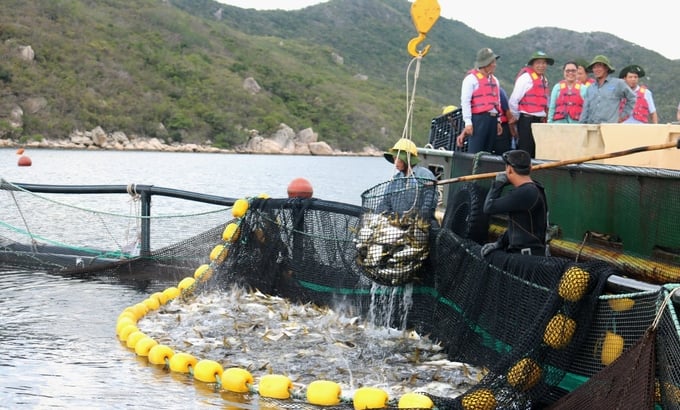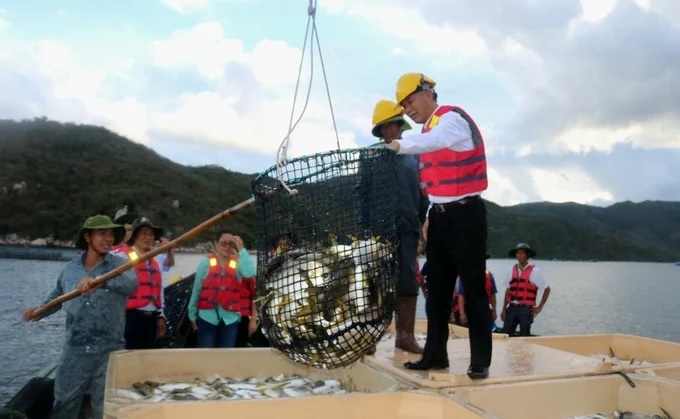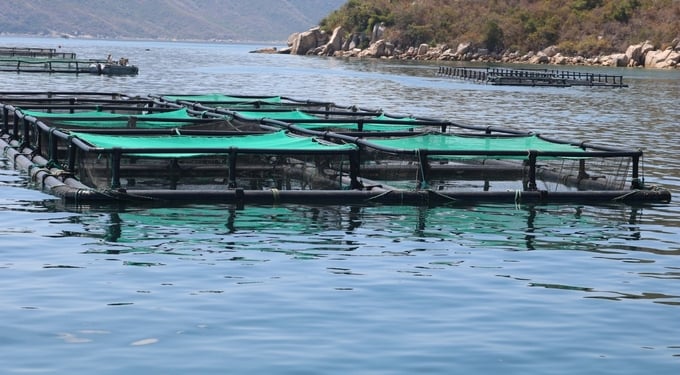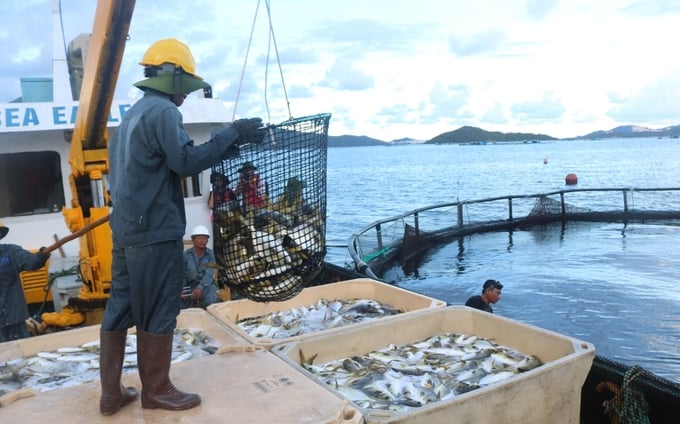May 30, 2025 | 01:55 GMT +7
May 30, 2025 | 01:55 GMT +7
Hotline: 0913.378.918
May 30, 2025 | 01:55 GMT +7
Hotline: 0913.378.918

Industrial marine farming model in Van Phong, Khanh Hoa province. Photo: Kim So.
Recent research of scientists shows that Khanh Hoa is one of the three provinces with big potential and advantages for marine farming. Its coastline is 385 km long with 200 islands large and small and many airtight waist lagoons such as Van Phong, Cam Ranh, Nha Trang. It is also a gathering place for many training and sea research institutions, including Nha Trang University, Nha Trang Oceanography Institute, and Research Institute for Aquaculture III, which help promote the development of aquaculture.
The marine farming scene at Khanh Hoa is vibrant, but there remain limitations. The majority of fishermen still follow the traditional methods. The cages are mostly made of wood, unable to withstand big waves. Some models do not have standard farming procedures or research new techniques through experiments. Farmers still use fresh feed, which results in environmental pollution.

Deputy Minister Phung Duc Tien visits an industrial marine farming model in Khanh Hoa. Photo: KS.
According to Nguyen Duy Quang, Director of Khanh Hoa Department of Agriculture and Rural Development, currently in the province there are only 3 industrial-scale sea farming models in Van Phong Bay: Australis Aquaculture Vietnam Ltd., the high technology marine farming center of Research Institute for Aquaculture I (RIA1) and Phuong Minh Aquaculture JSC.
Australis Aquaculture Vietnam Ltd. specializes in farming Asian sea bass, and has applied advanced technology such as automatic feeding systems, thus forming a closed production chain. The company has 70 HDPE cages, gaining an annual output of 6,000 - 8,000 tons of fish. As for RIA1’s hi-tech farming center, it has 42 HDPE cages with an average output of 200 - 250 tons of fish per cage, mostly golden pompano. Phuong Minh Aquaculture JSC also raises mostly golden pompano, using 11 HDPE cages with an output of 150 tons/year.

A corner of RIA1’s high-tech marine farming center. Photo: KS.
Khanh Hoa province aims to further promote industrial marine farming, apply modern technology and develop offshore through new management methods. The marine farming industry will strive to become an important part of the agricultural sector, contributing to improving the province's production value and aquaculture output. The pilot scheme for high-tech marine farming in Khanh Hoa has been consulted with relevant ministries and branches and is being completed before submitting to the Prime Minister for approval.
Bui Thi Ninh, Director of the Office of Employer of the Vietnam Chamber of Commerce and Industry (VCCI) - Ho Chi Minh City branch said, “Human resources for marine economy in general and industrial marine farming in particular are still lacking. Moreover, the production technique is mostly at a low level, not meeting the requirements of businesses”.

Industrial marine farming needs high quality human resources. Photo: KS.
On the other hand, the industrial marine farming program is currently not included in the formal training system, so the industry should build training models in line with the labor needs of the market. It is necessary to establish a cooperation mechanism between the State, the school and the enterprise in developing human resources.
The proactiveness of businesses must be highlighted when participating in the training process to build a team of high quality human resources which have sufficient knowledge and skills to meet the practical demands of the industry, as well as a solid foundation for advanced training during work.

Harvesting golden pompano. Photo: KS.
The high-tech marine farming center of RIA1 is a good example of the importance of human resources. To operate 20 round cages and 22 square cages, the center needs 11 members including 1 farm manager, 2 captains and chiefs, 3 divers with PADI certificates, 4 technical workers and 1 employee to take notes and collect data. All have been recruited and trained in labor safety rules, biosafety, first aid and marine farming techniques.
According to Pham Duc Phuong, Director of the high-tech marine farming center, they are human resources that determine the success or failure of the farm. They are the people who calculate the diet and feed amount, offer nutrition diet, care, disease prevention and storage of post-harvest products.
However, high quality human resources in Vietnam are hard to find. In order to bring the marine farming industry to a higher level, the issue of human resource training must be prioritized.
Translated by Samuel Pham
/2025/05/25/4127-3-073637_820.jpg)
(VAN) Thanks to the promotion from an FAO-implemented project, vegetable production in greenhouses in Moc Chau has seen strong development, from 1.5 hectares in 2021 to nearly 50 hectares in 2024.

(VAN) FAO has recently supported USD 140,000 to implement the project 'Risk mitigation human-animal interface risks through disease control initiatives in pig farming.'

(VAN) The People's Committee of Tra Vinh province has approved an adjustment to the investment policy for the Green Hydrogen Plant project, increasing its area to approximately 52.76 hectares.
![Reducing emissions from rice fields: [2] Farmers’ commitment to the soil](https://t.ex-cdn.com/nongnghiepmoitruong.vn/608w/files/news/2025/05/05/dsc08881jpg-nongnghiep-140632.jpg)
(VAN) Clean rice cultivation model in Thuong Tan commune, Bac Tan Uyen district, is assisting local residents in achieving sustainable agriculture by substantially reducing costs, increasing productivity, and protecting the environment.

(VAN) At the conference to disseminate Resolution No. 68, AgriS introduced its digital agricultural ecosystem and reaffirmed its commitment to accompanying the Government in promoting private sector development and sustainable agriculture.

(VAN) 'Blue Ocean - Blue Foods' initiative is designed to restore marine ecosystems and establish sustainable livelihoods for local communities by cultivating a minimum of 1,000 hectares of cottonii seaweed in the first three years.
/2025/05/21/4642-3-112707_603.jpg)
(VAN) The V-SCOPE project has made direct contributions to three out of six pillars of the Comprehensive Strategic Partnership between Vietnam and Australia.